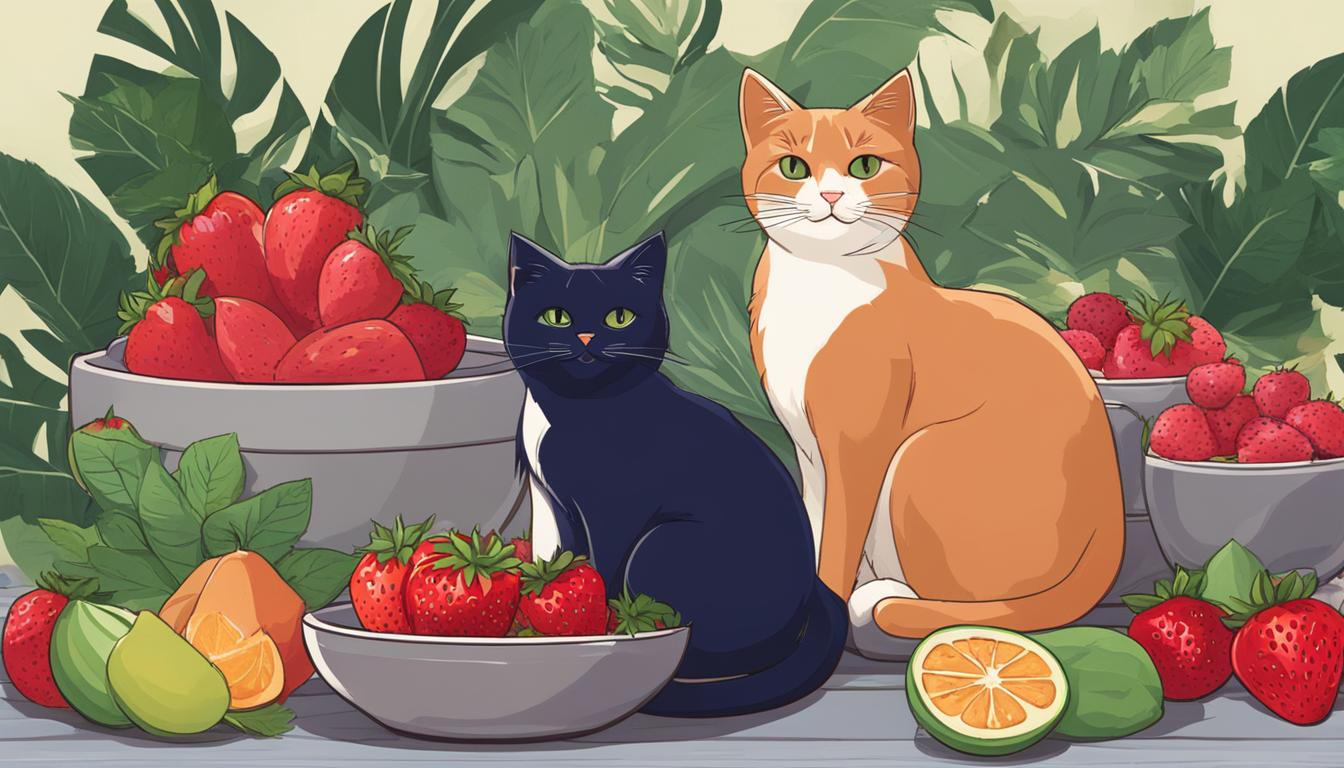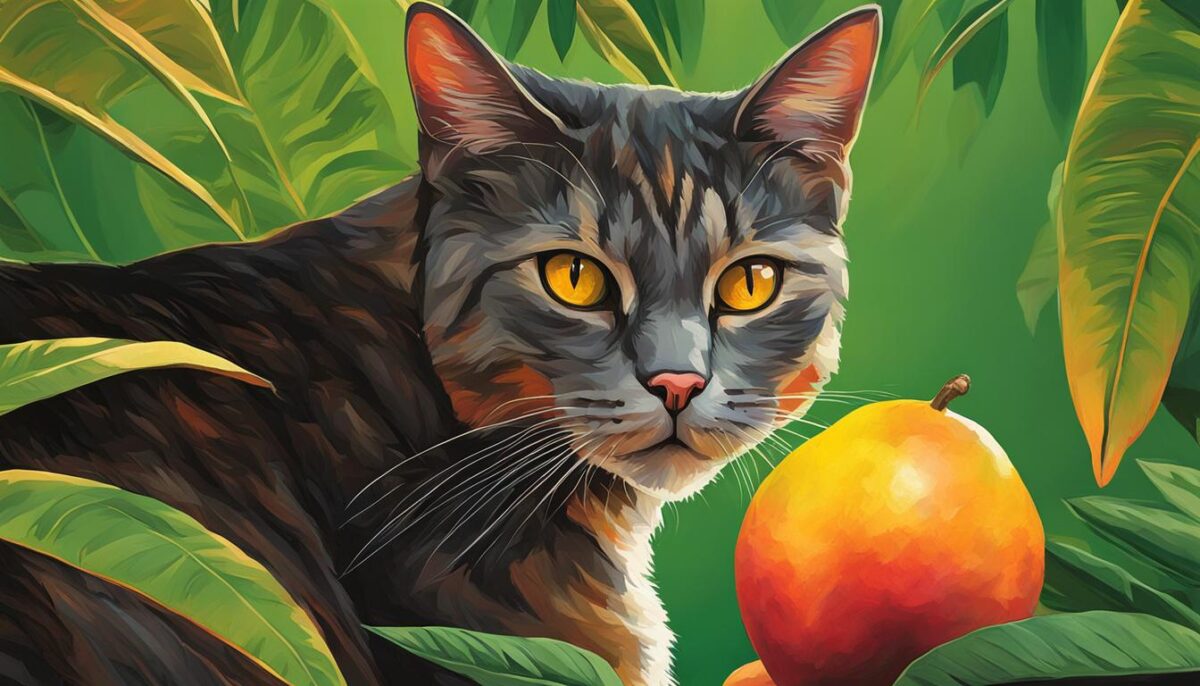Cats can enjoy a variety of fruits as part of their diet, but it’s important to choose ones that are safe for them. While cats are primarily meat eaters, certain fruits can be a tasty and healthy treat for them in moderation. In this article, we will explore some cat-friendly fruits that your furry friend can safely consume.
Before introducing any new fruits to your cat, it’s crucial to take certain precautions. Not all fruits are safe for cats, and some can even be toxic to them. By selecting the right fruits and following the recommended serving sizes, you can ensure that your feline companion enjoys these treats without any harm. Let’s dive in and discover which fruits are suitable for your cat’s diet.
Key Takeaways:
- Choose fruits that are safe for cats and avoid any that may be toxic to them.
- Apples, bananas, mangos, and strawberries are cat-friendly fruits that can be given in moderation.
- Remove any toxic parts, such as seeds, stems, or peels, before offering fruits to your cat.
- Always prioritize your cat’s health and well-being when introducing new foods into their diet.
- Consult with your veterinarian if you notice any signs of digestive upset after introducing a new fruit.
Apples: A Crunchy and Hydrating Fruit for Cats
Apples are not only a delicious and crunchy fruit for us humans but can also be a healthy and refreshing treat for your feline friend. Cats can safely enjoy small quantities of apples as part of their diet, thanks to the numerous nutritional benefits they offer.
Apples are high in fiber, which aids in digestion and helps prevent constipation in cats. They are also packed with essential vitamins, including vitamin K, A, and C, which are important for maintaining a healthy immune system and promoting overall wellbeing. Additionally, apples contain antioxidants that can help reduce inflammation and support your cat’s overall health.
One important precaution to keep in mind when offering apples to your cat is to remove the stem and seeds. While apple flesh itself is safe for cats, the stem and seeds contain small amounts of cyanide, which can be toxic to felines. To ensure your cat’s safety, it’s recommended to slice the apple into tiny pieces and serve them in moderation, limiting the quantity to one or two pieces.
Remember, while apples can be a tasty and hydrating treat for your cat, they should not replace a balanced and complete cat food diet. Consult with your veterinarian before introducing any new foods to your cat to ensure their specific dietary needs are being met.
Table: Nutritional Content of Apples
| Nutrient | Amount per 100g |
|---|---|
| Calories | 52 |
| Fiber | 2.4g |
| Vitamin K | 2.2mcg |
| Vitamin A | 3mcg |
| Vitamin C | 0.5mg |
| Antioxidants | Yes |
As shown in the table, apples are a low-calorie fruit that provides a good amount of fiber and essential vitamins. These nutritional components can contribute to your cat’s overall health and well-being, making apples a beneficial and cat-friendly addition to their diet.
“Apples are a healthy and hydrating option for your cat, providing essential nutrients and antioxidants. Remember to remove the stem and seeds before sharing this tasty treat with your feline friend.”
Bananas: A Nutritious Treat for Feline Friends
Bananas can be a safe and nutritious treat for your cat. They are packed with essential vitamins and minerals that can benefit your feline friend’s overall health. Bananas are rich in vitamin B6, which helps support brain function, metabolism, and the production of red blood cells. They also contain vitamin C, an antioxidant that boosts the immune system and promotes healthy skin. Additionally, bananas are a good source of potassium, which aids in maintaining proper heart and muscle function.
When introducing bananas to your cat’s diet, it’s important to remember a few key points. Firstly, bananas should be served in moderation. While they are a healthy snack, their high sugar content means that too many can lead to weight gain and other health issues. It’s best to offer small slices or chunks as an occasional treat, rather than making bananas a regular part of your cat’s meals.
Secondly, make sure to offer ripe bananas to your cat. Unripe bananas can be challenging for cats to digest and may cause gastrointestinal upset. Look for bananas that are fully yellow and slightly soft, as these are the most palatable and easy to eat for your feline friend.
Lastly, it’s crucial to remember that every cat is unique, and some may have sensitivities or allergies to bananas. If you notice any signs of digestive upset or an adverse reaction after introducing bananas, it’s best to discontinue the treat and consult with your veterinarian.
| Vitamin | Benefit |
|---|---|
| Vitamin B6 | Supports brain function, metabolism, and red blood cell production |
| Vitamin C | Boosts the immune system and promotes healthy skin |
| Potassium | Aids in maintaining proper heart and muscle function |
The Bottom Line
While bananas can be a nutritious and tasty treat, it’s important to offer them in moderation and be mindful of your cat’s individual preferences and sensitivities. As with any new food, it’s always a good idea to consult with your veterinarian before introducing bananas or any other fruits into your cat’s diet. By considering your cat’s health needs and following these guidelines, you can safely incorporate bananas into your feline friend’s treat repertoire.
Mangos and Strawberries: Exotic and Immunity-Boosting Fruits for Cats
Mangos and strawberries can add a touch of exotic flavor to your cat’s diet while providing several health benefits. Let’s explore why these fruits are safe and beneficial for your feline friend.
Mangos for Cats
Mangos are packed with essential nutrients that can support your cat’s overall well-being. They are rich in fiber, vitamins C, A, and B6, which contribute to your cat’s digestive and eye health. The high fiber content in mangos helps regulate digestion and can prevent constipation in cats. Additionally, the antioxidants in mangos can strengthen your cat’s immune system, protecting them against diseases.
Strawberries for Cats
Strawberries are a favorite among many pets and can be a healthy treat for your cat. They are rich in potassium, fiber, vitamins C, B1, B6, antioxidants, and folate. The fiber in strawberries aids in digestion and can help prevent hairballs in cats. The high vitamin C content can boost your cat’s immune system and promote healthy skin and coat. However, it’s important to note that strawberries should be given in moderation due to their natural sugar content.
Feeding Guidelines
When offering mangos and strawberries to your cat, it’s important to prepare them properly and feed them in moderate amounts. Here are some guidelines to follow:
- Remove the pit and peel from mangos before serving. Cats can safely enjoy 1-2 small slices of mango per day.
- Wash strawberries carefully, remove the stems and leaves, and offer them in small quantities, around 1-2 pieces.
- Always monitor your cat’s response to new foods and consult with your veterinarian if you notice any signs of digestive upset or allergies.
Remember that while fruits can be a healthy addition to your cat’s diet, they should not replace their main source of nutrition, which should come from a balanced cat food. As always, prioritize your cat’s health and well-being when introducing new foods.
Conclusion
Cats can enjoy a variety of fruits as part of their diet, as long as you take some precautions. It’s essential to choose fruits that are safe for cats and remove any toxic parts, like seeds, stems, or peels. Apples, bananas, mangos, strawberries, and many other fruits can be a healthy and tasty addition to your cat’s menu.
However, it’s important to offer fruits in moderation and ensure that the majority of their diet comes from complete and balanced cat food. Fruits should be considered as treats or occasional snacks, not as a replacement for proper cat nutrition.
If you decide to introduce a new fruit to your cat’s diet, keep an eye out for any signs of digestive upset. If you notice any changes or concerns, it’s best to consult with your veterinarian to ensure the well-being of your feline friend.
Remember, the key is to prioritize your cat’s health and well-being when it comes to introducing new foods into their diet. Enjoy exploring the world of cat-friendly fruits, and keep your furry friend happy and healthy!
FAQ
Can cats eat apples?
Yes, cats can eat apples. However, make sure to remove the stem and seeds, as they can be toxic to cats. Offer small slices or cubes of apples in moderation.
Are bananas safe for cats?
Yes, bananas are safe for cats. They are rich in vitamins and potassium. Offer sliced bananas in moderation due to their high sugar content.
Can cats eat mangos?
Yes, cats can eat mangos. Remove the pit and peel before serving. Offer 1-2 small slices of mango per day.
Are strawberries safe for cats?
Yes, strawberries are safe for cats. Wash them carefully, remove the stems and leaves, and offer them in small quantities.
Should fruits be the main part of a cat’s diet?
No, fruits should not be the main part of a cat’s diet. They can be given as a treat in moderation. The bulk of their diet should come from complete and balanced cat food.

